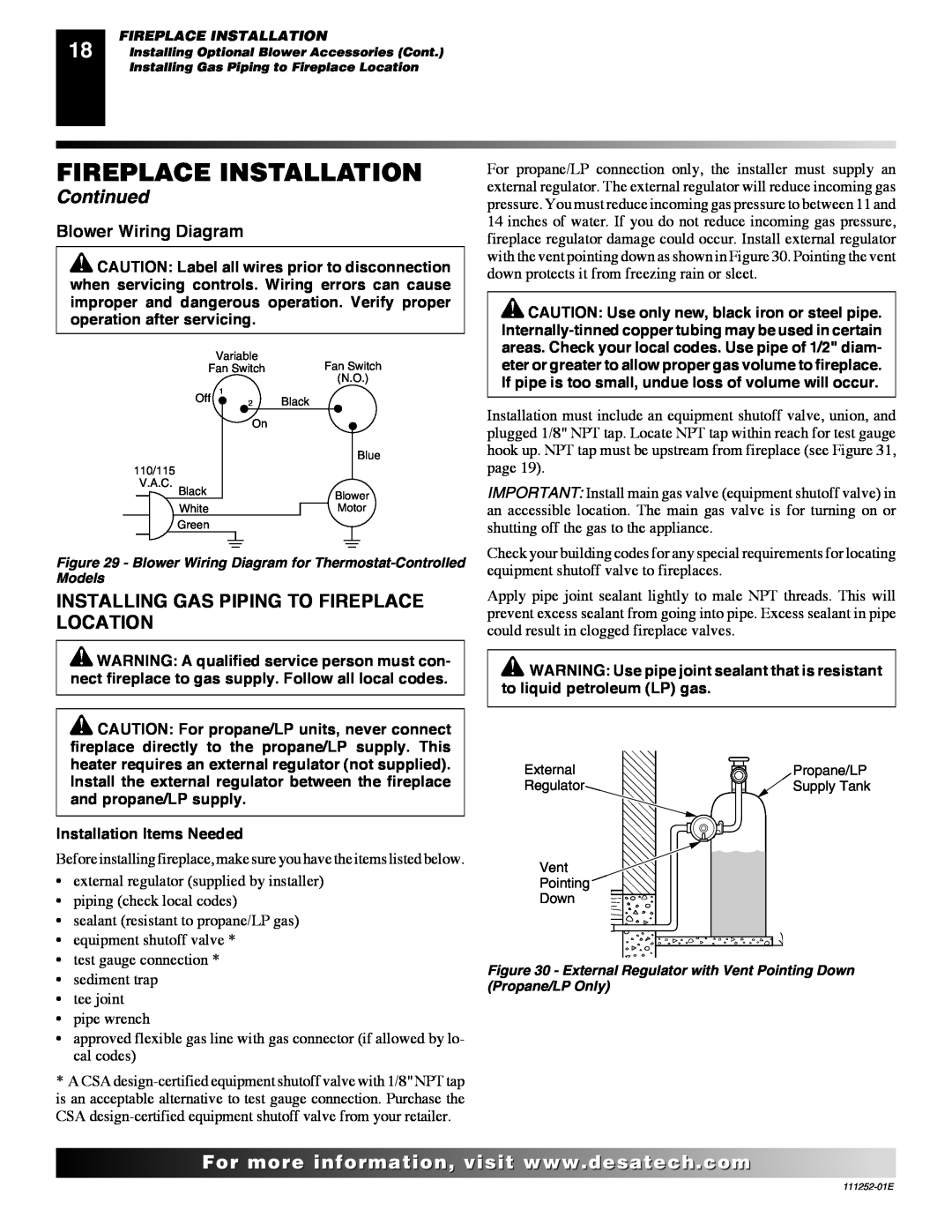
18 | FIREPLACE INSTALLATION |
Installing Optional Blower Accessories (Cont.) | |
| Installing Gas Piping to Fireplace Location |
|
|
FIREPLACE INSTALLATION
Continued
Blower Wiring Diagram
![]() CAUTION: Label all wires prior to disconnection when servicing controls. Wiring errors can cause improper and dangerous operation. Verify proper operation after servicing.
CAUTION: Label all wires prior to disconnection when servicing controls. Wiring errors can cause improper and dangerous operation. Verify proper operation after servicing.
Variable
Fan SwitchFan Switch
(N.O.)
Off 1 | 2 | Black |
| On |
|
Blue
110/115
V.A.C.
Black | Blower | |||||||
| ||||||||
White | Motor | |||||||
Green |
|
|
|
|
|
|
|
|
|
|
|
|
|
|
|
|
|
|
|
|
|
|
|
|
|
|
|
|
|
|
|
|
|
|
|
Figure 29 - Blower Wiring Diagram for
INSTALLING GAS PIPING TO FIREPLACE LOCATION
![]() WARNING: A qualified service person must con- nect fireplace to gas supply. Follow all local codes.
WARNING: A qualified service person must con- nect fireplace to gas supply. Follow all local codes.
![]() CAUTION: For propane/LP units, never connect fireplace directly to the propane/LP supply. This heater requires an external regulator (not supplied). Install the external regulator between the fireplace and propane/LP supply.
CAUTION: For propane/LP units, never connect fireplace directly to the propane/LP supply. This heater requires an external regulator (not supplied). Install the external regulator between the fireplace and propane/LP supply.
Installation Items Needed
Before installing fireplace, make sure you have the items listed below.
•external regulator (supplied by installer)
•piping (check local codes)
•sealant (resistant to propane/LP gas)
•equipment shutoff valve *
•test gauge connection *
•sediment trap
•tee joint
•pipe wrench
•approved flexible gas line with gas connector (if allowed by lo- cal codes)
*A CSA
For propane/LP connection only, the installer must supply an external regulator. The external regulator will reduce incoming gas pressure. You must reduce incoming gas pressure to between 11 and 14 inches of water. If you do not reduce incoming gas pressure, fireplace regulator damage could occur. Install external regulator with the vent pointing down as shown in Figure 30. Pointing the vent down protects it from freezing rain or sleet.
![]() CAUTION: Use only new, black iron or steel pipe.
CAUTION: Use only new, black iron or steel pipe.
Installation must include an equipment shutoff valve, union, and plugged 1/8" NPT tap. Locate NPT tap within reach for test gauge hook up. NPT tap must be upstream from fireplace (see Figure 31, page 19).
IMPORTANT: Install main gas valve (equipment shutoff valve) in an accessible location. The main gas valve is for turning on or shutting off the gas to the appliance.
Check your building codes for any special requirements for locating equipment shutoff valve to fireplaces.
Apply pipe joint sealant lightly to male NPT threads. This will prevent excess sealant from going into pipe. Excess sealant in pipe could result in clogged fireplace valves.
![]() WARNING: Use pipe joint sealant that is resistant to liquid petroleum (LP) gas.
WARNING: Use pipe joint sealant that is resistant to liquid petroleum (LP) gas.
External | Propane/LP |
Regulator | Supply Tank |
Vent
Pointing
Down
Figure 30 - External Regulator with Vent Pointing Down (Propane/LP Only)
![]()
![]()
![]()
![]()
![]() For
For![]()
![]()
![]()
![]()
![]()
![]()
![]()
![]()
![]()
![]()
![]()
![]()
![]() .
.![]()
![]()
![]()
![]() .com
.com![]()
![]()
![]()
![]()
![]()
